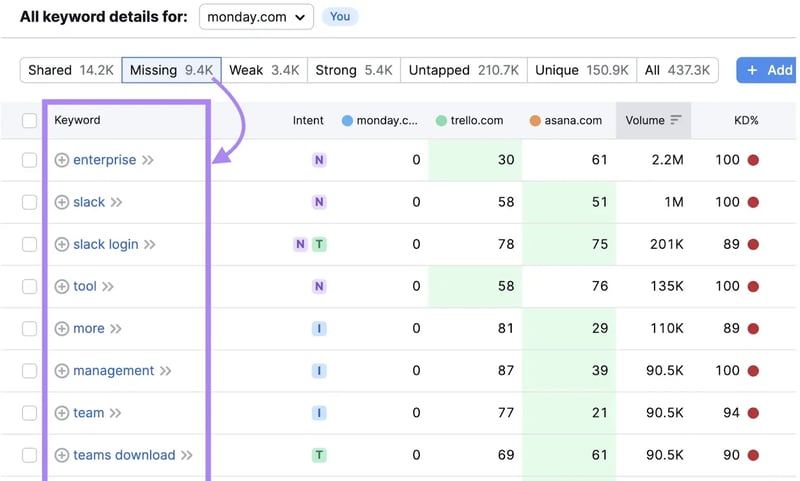Many businesses invest time and resources into content creation, yet they often miss valuable opportunities to capture organic traffic. One of the main reasons this occurs is that they may not fully understand which keywords they’re overlooking. This is where keyword gap analysis becomes essential.
By comparing your keyword profile with competitors, you can discover new SEO opportunities, strengthen your content strategy, and stay ahead in search rankings.

What Is Keyword Gap Analysis?
Keyword gap analysis is the process of identifying the keywords that your competitors rank for, but you don’t. By conducting this analysis, you can find high-value terms driving traffic to other websites and incorporate them into your own SEO strategy. This isn’t just about spotting missing words. It’s about recognizing patterns in competitor success and applying that knowledge to optimize your content.
The ultimate goal of a keyword gap analysis is to close the gap so that your content ranks alongside or above your competitors’ for valuable search terms.
Why Keyword Gap Analysis Matters
Without performing a keyword gap analysis, your content strategy relies on guesswork. You risk creating content that doesn’t address what your audience is actively searching for, leaving that traffic to your competitors.
Analyzing keyword gaps allows you to discover untapped opportunities, optimize your time and budget, and improve your search visibility. Over time, this practice helps you understand market trends, align content with your audience’s needs, and refine your overall SEO strategy to achieve maximum impact.
Keyword Gap Analysis vs. Content Gap Analysis
While related, keyword gap analysis and content gap analysis serve distinct purposes. A keyword gap analysis focuses on specific search terms competitors rank for, whereas content gap analysis identifies broader topics that are missing from your content strategy.
For example, a SaaS company might discover through keyword gap analysis that its competitors rank for terms like “CRM for small business automation” or “free CRM with email integration.”
Content gap analysis, on the other hand, might reveal opportunities to produce guides, case studies, or tutorials that address the full customer journey. Both analyses complement each other, but the keyword gap is more targeted toward immediate SEO gains.
How to Perform a Keyword Gap Analysis
Start by building a competitor list that includes both direct competitors offering similar products and SEO competitors ranking for your target keywords. You can identify these competitors through Google searches, industry forums, and social media, or by analyzing search results for key terms in your niche.
Next, choose a reliable SEO tool to gather data. Tools like Semrush, Ahrefs, and Clearscope simplify the process of comparing keyword performance across sites. Once you’ve selected your tool, compile a list of keywords that your competitors rank for and those that your site currently targets. Pay attention to metrics like search volume, keyword difficulty, and competitive density to identify the most valuable opportunities.

Once you have the data, evaluate which keywords you can realistically rank for. Focus on terms that align with your existing content or that allow you to create new, relevant pieces of content. Examine competitor pages to understand why their content performs well and look for gaps that you can capitalize on, such as location-based keywords or industry-specific topics they may have overlooked.
Finally, develop or optimize your content to target these gaps. Use keywords strategically in titles, headers, meta descriptions, URLs, and body text, while keeping the content relevant and valuable for readers. Lastly, track your progress by monitoring traffic, keyword rankings, and conversion metrics, updating your strategy as trends and competition evolve.
Creating a Keyword Gap Analysis Template
Templates created on Excel or similar platforms can facilitate the analysis process by keeping all keyword data, competitor insights, and priorities in one place. Start by entering your company and competitor names, then input the keywords each site ranks for. Label whether your site is “ranked” or “not ranked” for each keyword to quickly spot gaps. Analyze search volume, difficulty, and relevance to prioritize high-impact terms. Finally, implement strategies such as content optimization, new content creation, and SEO adjustments to target these keywords effectively.
This approach is particularly useful for digital marketing teams, startups with limited budgets, and small businesses seeking an organized, actionable framework to improve SEO performance without having to worry about overspending.
Conclusion
A keyword gap analysis is a powerful tool for uncovering missed SEO opportunities and staying competitive. By identifying keywords your competitors rank for but you don’t, you can refine your content strategy, target high-value search terms, and ultimately drive more organic traffic to your website.
By strategically addressing these gaps, businesses can boost search visibility, align content with audience needs, and establish a clear competitive advantage. This practice ensures that your content is always working as efficiently as possible.
Responsable de la estrategia de contenidos y visibilidad en Cyberclick, con enfoque Allbound y especialización en posicionamiento SEO, GEO y automatización con IA. Gestión avanzada del CRM con HubSpot: base de datos, workflows, lead nurturing, scoring y reporting. Experiencia en marketing digital, comunicación corporativa y periodismo, uniendo estrategia, creatividad y tecnología para captar y convertir leads cualificados.
Responsible for content and brand visibility strategy at Cyberclick, with an Allbound approach and specialization in SEO, GEO (Generative Engine Optimization), and AI-powered automation. Advanced HubSpot CRM management: database segmentation, workflows, lead nurturing, scoring, and reporting. Background in digital marketing, corporate communications, and journalism—combining strategy, creativity, and technology to attract and convert qualified leads.






Leave your comment and join the conversation